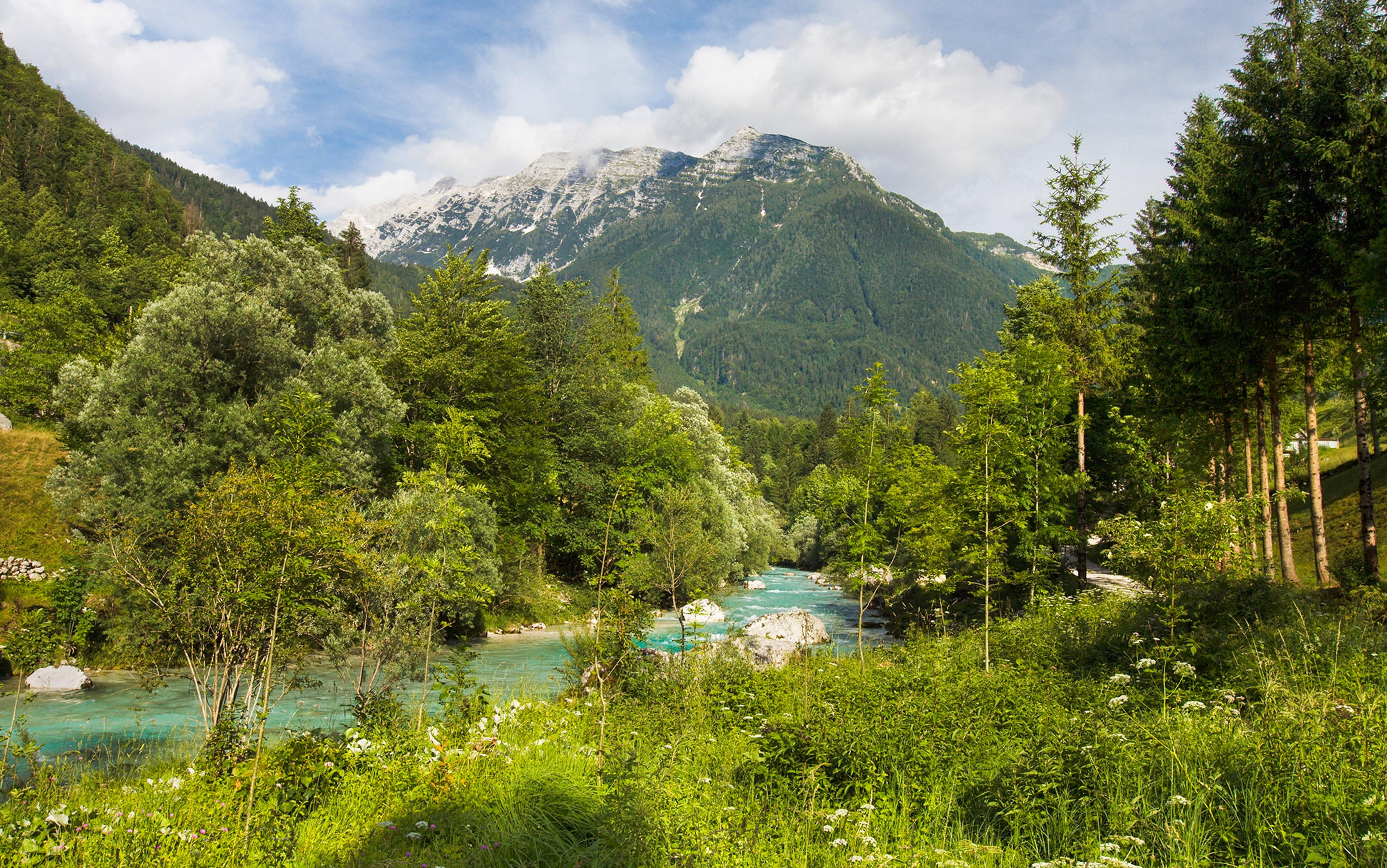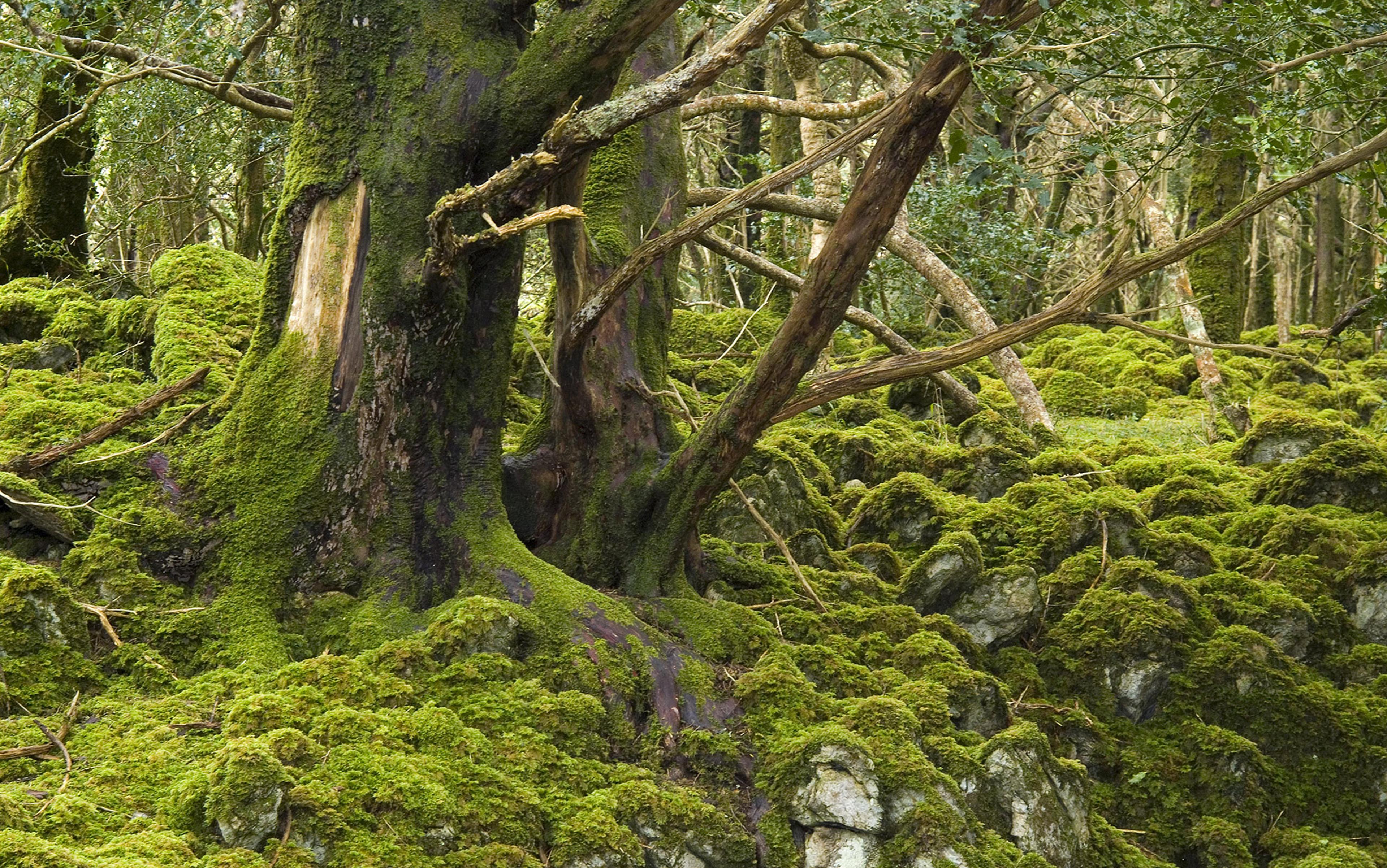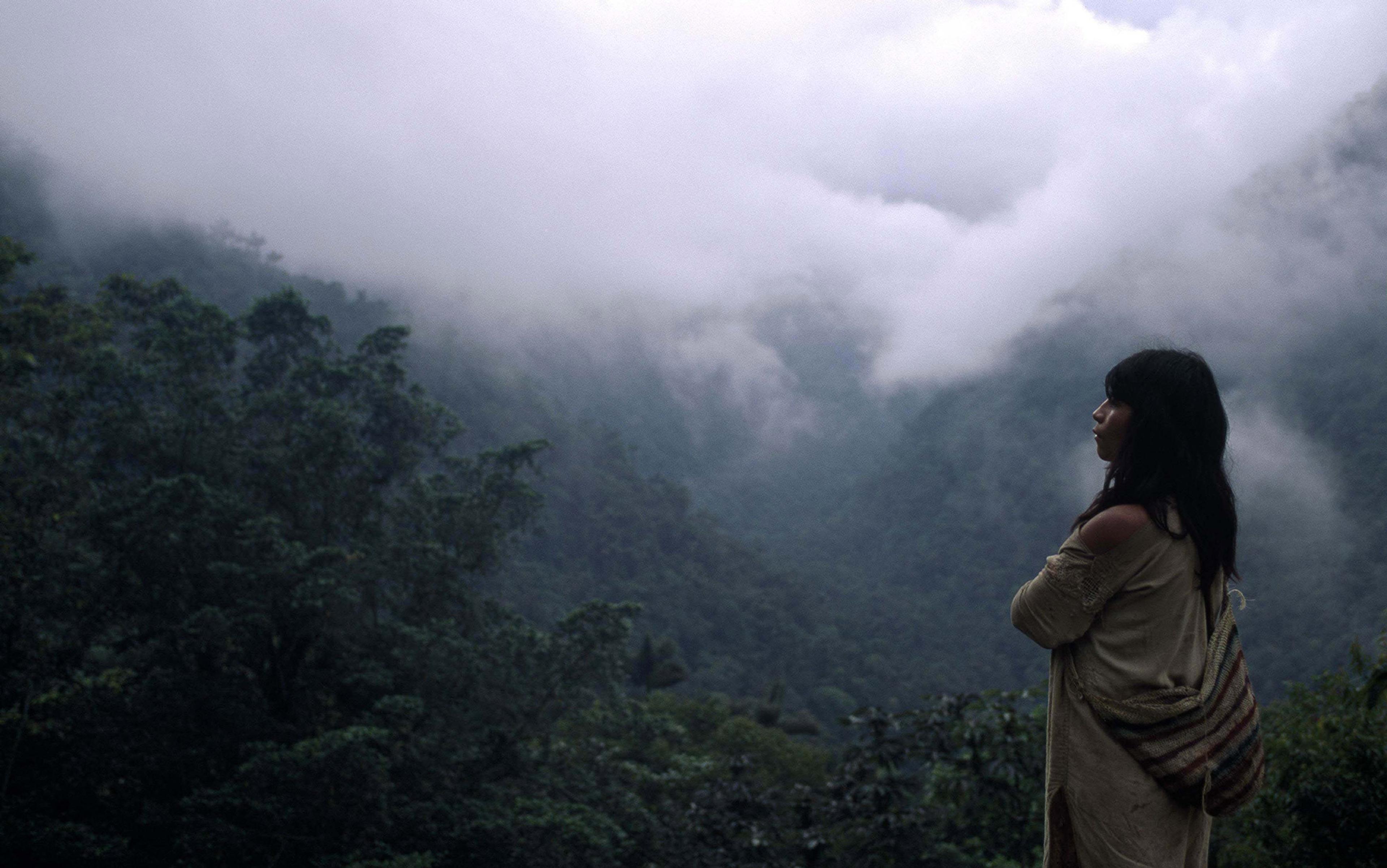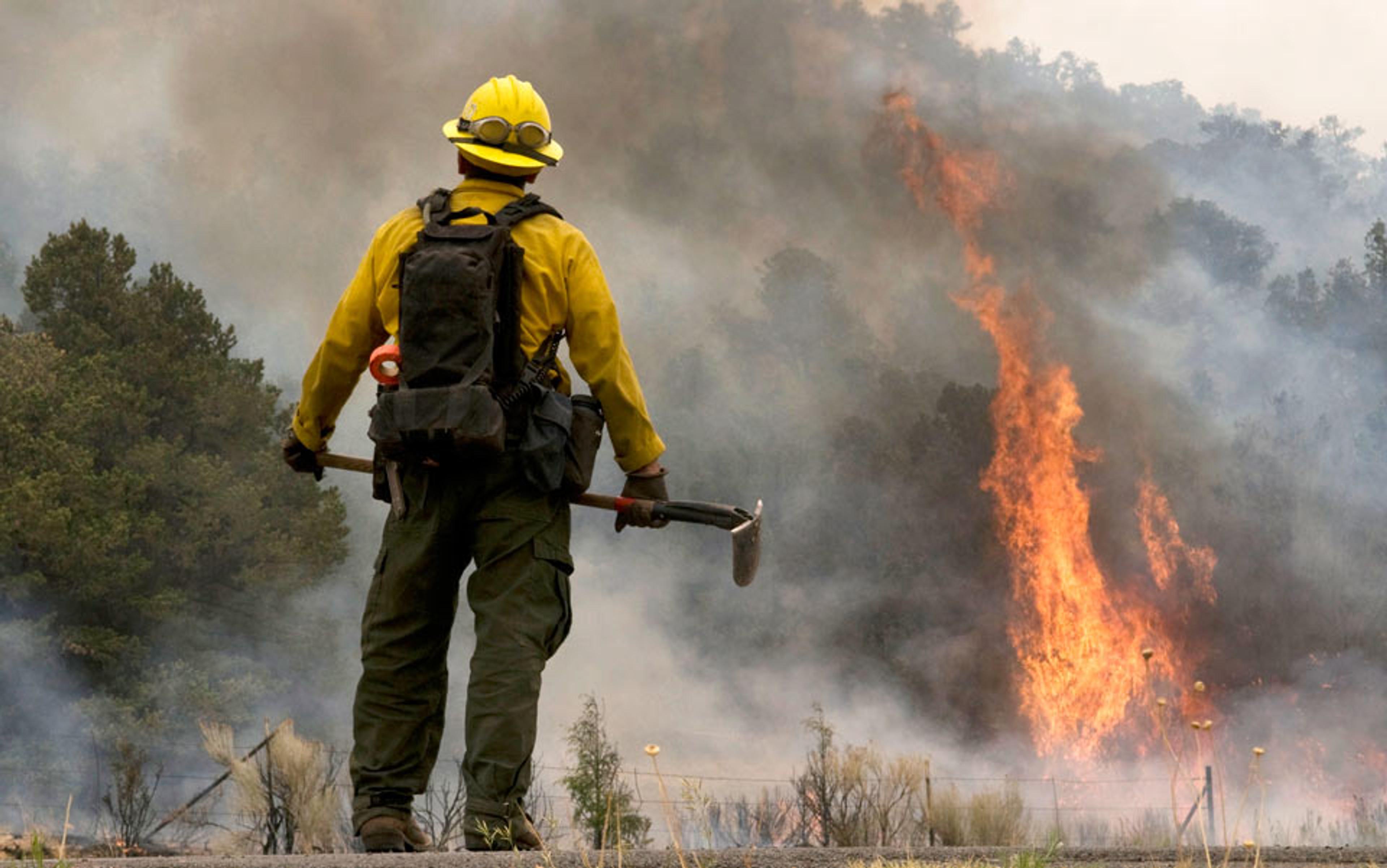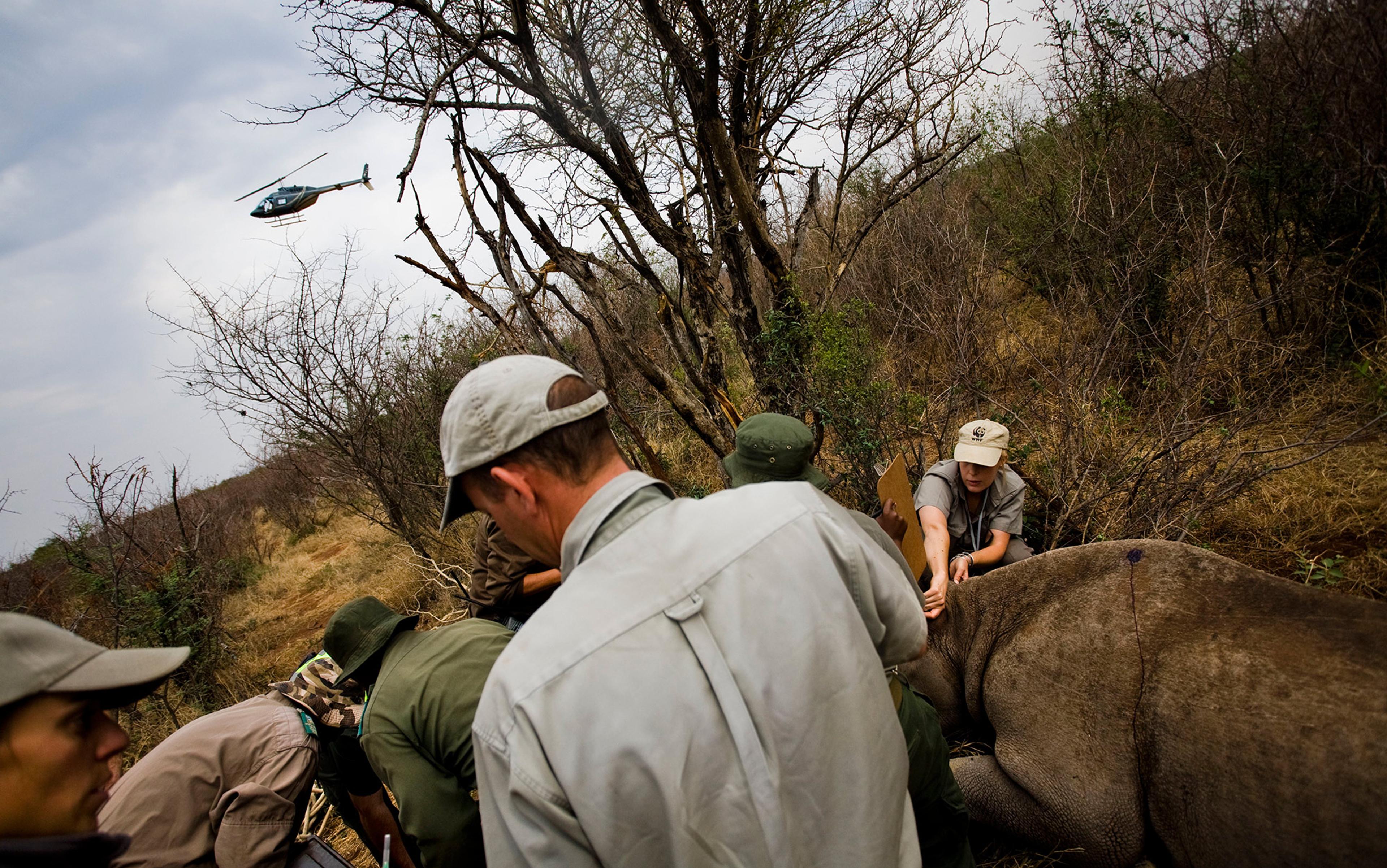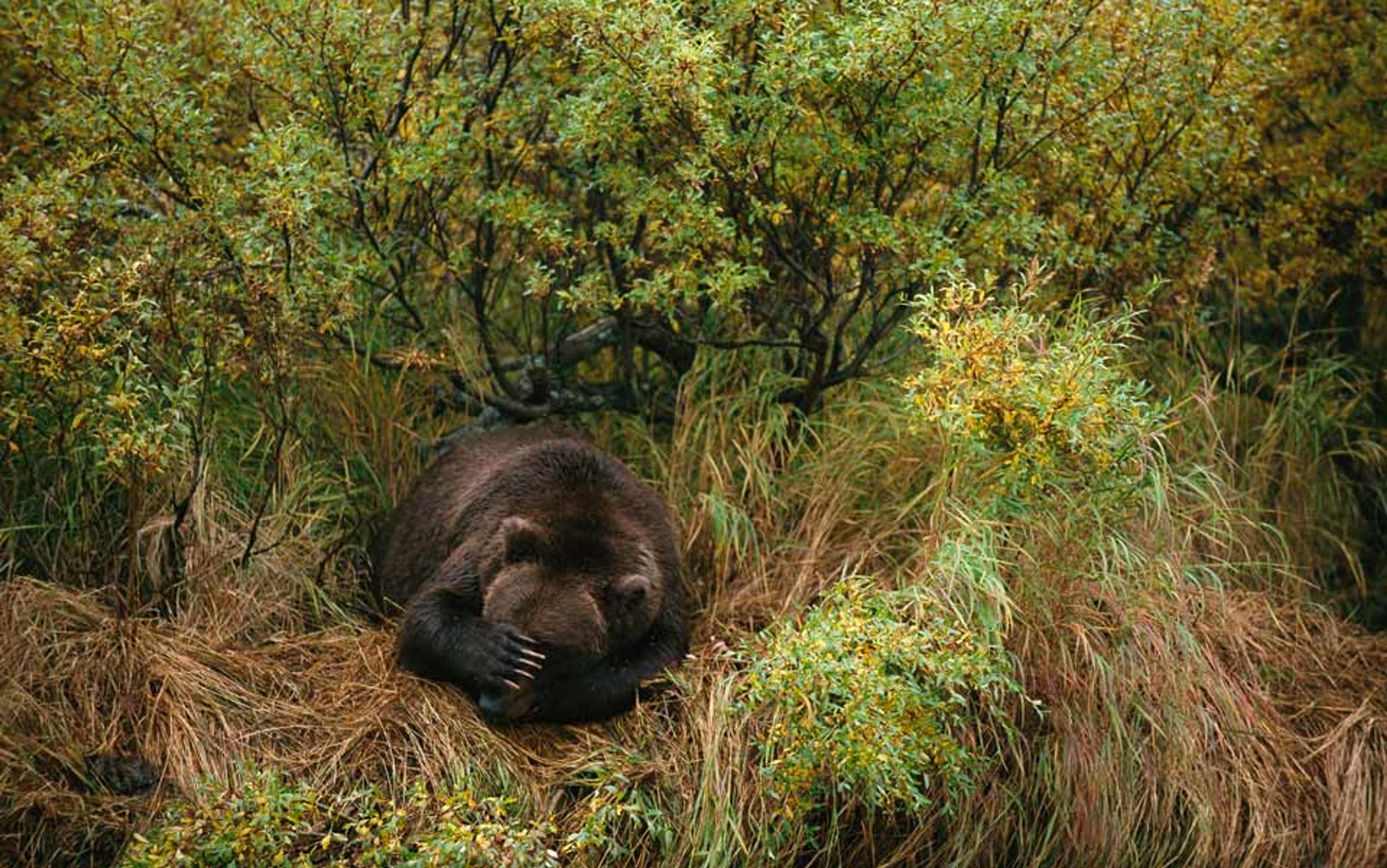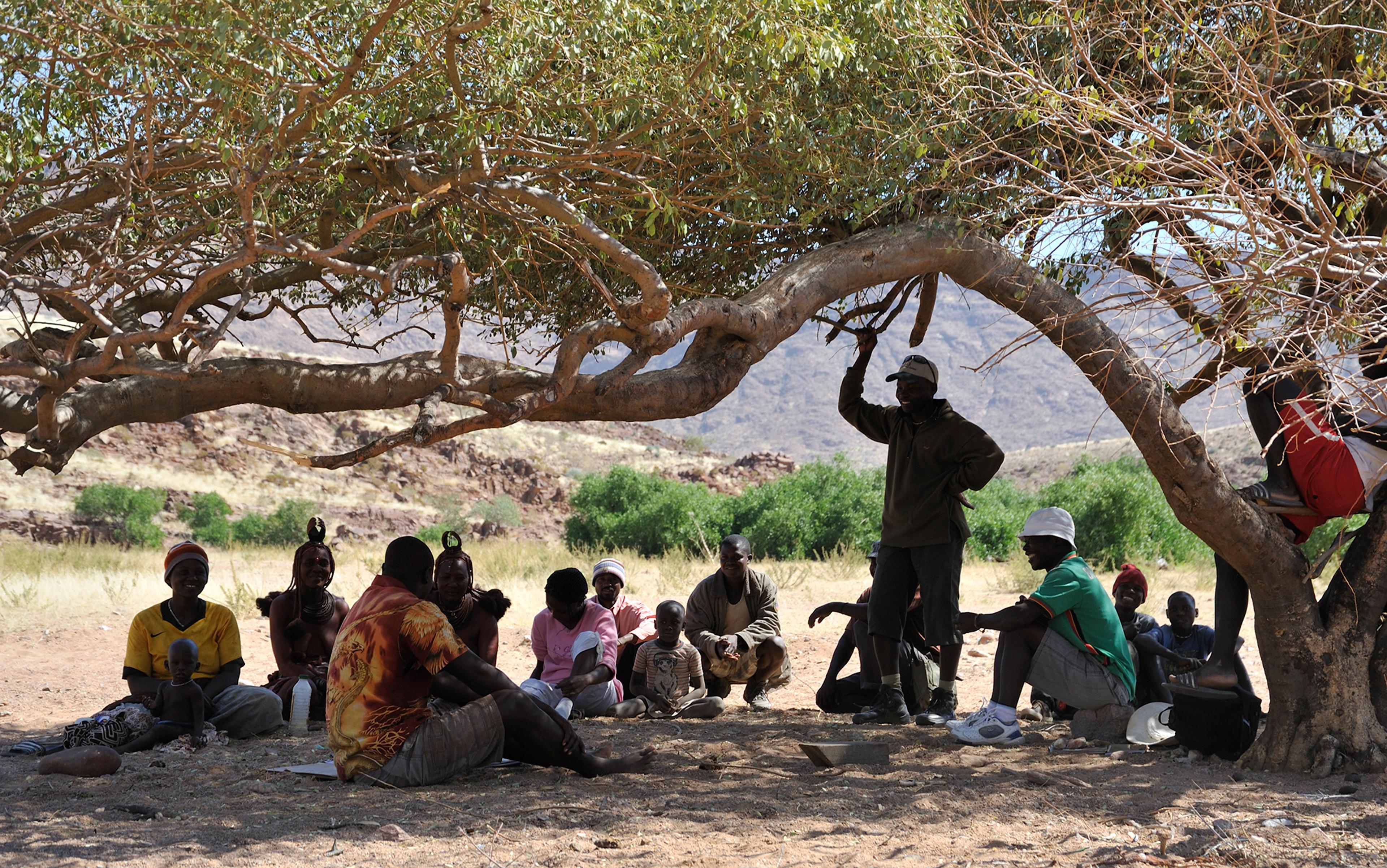I stepped out into the sunlight, scarcely able to believe what I had seen or, rather, what I had not. I stared at the hills around me, contrasting them with the old photos of those same hills I had seen. Where dense forests now grew, forming a high, closed canopy — in the valleys, over the hills and up the mountain walls until they shrank, many thousands of feet above sea level, into a low scrub of pines, which diminished further to a natural treeline — there had been almost nothing. In the photos, taken on the western side of Slovenia during the First World War, the land was almost treeless.
So tall and impressive are the trees now and so thickly do they now cover the hills that when you see the old photos — taken, in ecological terms, such a short time ago — it is almost impossible to believe that you are looking at the same place. I have become so used to seeing the progress of destruction that scanning those images felt like watching a film played backwards.
Tomaž Hartmann had driven for almost an hour along a forest track through Kočevski Rog to bring us here. The woods of beech and silver fir towered over us, in places almost touching across the road. Their roots sprawled over mossy boulders. They rolled down into limestone sinkholes: karstic craters. Karst topography — weathered limestone landscapes of chasms and caves, sinkholes, shafts and pavements — is named after this region of Slovenia, which is sometimes called the Kras or Karst plateau. The word means barren land. When Karst landscapes are grazed, they are rapidly denuded, but it was hard to connect the term with what I now saw.
Where the road clung to the edge of a hill, I could see for many miles across the Dinaric Mountains. The mountains rambled across the former Yugoslavia, fading into ever fainter susurrations of blue. The entire range was furred with forest. Where the road sank into a pass, the darkness closed around us. Through the trunks I could see the air thicken, shade upon shade of green. A few yards from the road, a fox sat watching us. Its copper fur glowed like a cinder in the shadows, which cooled to charcoal in the tips of its ears. It raised its black stockings and loped away into the depths. Woodpeckers swung along the track ahead of us.
The leaves of the beeches glittered in the silver light above our heads. The great firs grazed the sun, straight as lances. They looked as if they had been there forever.
‘All this,’ Tomaž told us, ‘has grown since the 1930s.’
He parked the car and we set off up a forest trail. Mushrooms nosed through the leaf litter beside the path. Saffron milk caps, orange and sickly green, curled up at the edges like Japanese ceramics. Dryad’s saddle, sulphur tuft and cauliflower fungus accreted around rotting stumps. Russulas — scarlet, mauve and gold — brightened the forest floor.
Tomaž led us up a limestone slope towards a stand of virgin forest, the ancient core of the great woods that had regenerated over the past century. As we climbed, we stepped into a ragged fringe of cloud. Sounds were muffled. The trees loomed darkly out of the fog. As we walked, Tomaž spoke about the dynamism of the forest system: how it never reached a point of stasis, but tumbled through a constant cycle of change. He had noticed some major shifts, and knew that, as the climate warmed, there would be plenty more. Though he described himself as both a forester and a conservationist, he had no wish to interrupt this cycle, or to seek to select and freeze a particular phase in the succession from one state to another. He sought only to protect the forests, as far as his job permitted, from destruction.
Ahead of us something dark and compact shot across the path in a blur and disappeared into the undergrowth: probably a young wild boar, Tomaž said. Then, though it was not clear where the transition had occurred, we found ourselves in the primeval core of the forest. The trees we had walked past until then were impressive, but these were built on a different scale. The beeches grew, unbranched — smooth pillars wrapped in elephant skin — for 100 feet until they blossomed, like giant gardenias, into a leafy plateau in the forest canopy. Silver firs pushed past them, the biggest topping out at almost 150 feet high. Only where they had fallen could you appreciate the scale of their trunks.
The forests blotted out memories of what had gone before. Humanity’s loss was nature’s gain
The forest had entered a cycle Tomaž had not seen before, in which many of the giants had perished. Some had died where they stood, and remained upright, reamed with beetle and woodpecker holes, sprouting hoof fungus and razor strop. They looked as if a whisper of wind could blow them down. Others now stretched across the rocks and craters, sometimes blocking our path, sometimes suspended above our heads. Among the trunks lying on the ground, some were so thick that I could scarcely see over them. Where they had fallen, thickets of saplings crowded into the light. Seeing the profusion of fungus and insect life the dead wood harboured, I was reminded of the old ecologists’ aphorism: there is more life in dead trees than there is in living trees. The tidy-minded forestry so many nations practise deprives many species of their habitats.
On a large rotten log that had lost its bark and was now furry with green algae, Tomaž showed us two sets of four white marks: deep parallel scratches where a bear had sharpened its claws. He told us that he had seen plenty of bears in the forest, but never a wolf or a lynx — though they are also abundant here. Just knowing that they were there enriched and electrified every moment he spent in the forest. I felt it too, like a third beat of the heart. The forest seemed to bristle with possibility. Here, to mangle W H Auden, nature’s jungle growths were unabated, her exorbitant monsters unabashed. But this great rewilding, Tomaž explained, had come at a price. It was the accidental result of a series of human tragedies.
Some 150 years ago, just 30 per cent of the Kočevje region was covered by trees; now, 95 per cent of it is forested. Much of the forest was preserved by the princes of Auersperg as hunting estates. So obsessed by hunting were they, as princes often seem to be, that they and the other great lords of the Habsburg monarchy in Slovenia and Croatia drew up an official declaration of friendship with the bear, signed and stamped with their great seals, in which they agreed to sustain its numbers so that they could continue to pursue it. The role the bears played in this negotiation is unrecorded.
The revolutions of 1848 brought feudalism to an end in central Europe. Local farmers lost their rights to graze common land, but acquired their own private plots. At around the same time, imports of cheap wool from New Zealand began undermining the European industry. By the end of the 19th century, many peasant farmers had sold their land and either moved to the cities or emigrated to America. The Depression of the 1930s further extended the woods — to around 50 per cent of Kočevje — as more people departed. But the greatest expansion of the forest took place as a result of what happened in the following decade.
Most of the population of south-western Slovenia — around 33,000 people — was ethnic German. They kept sheep and goats in the hills and ran much of the trade in the towns. Under King Aleksandr’s autocracy in the ten years before the Second World War, the Germans of Yugoslavia, around half a million in total, suffered discrimination and exclusion. In response, many of them joined German nationalist movements, some of which allied themselves to the Nazis. By 1941, when Hitler’s army invaded Yugoslavia, more than 60 per cent of its ethnic Germans had joined an organisation called the Kulturbund, which became absorbed into Himmler’s euphemistically titled Volksdeutsche Mittelstelle, or Ethnic Germans’ Welfare Office.
Hitler ceded south-western Slovenia to Italy, and the Nazis forcibly relocated many of the Yugoslav Germans to the Third Reich, to preserve their ‘ethnic purity’ and protect them from attacks by partisans. Some of the Germans of Kočevje were transferred to eastern Slovenia, some removed to other lands under German rule.
So feracious is the vegetation of the Amazon that it would have obliterated all visible traces of the civilisations built by its people within a few years of their dissolution
Almost a million people died in the Yugoslavian civil strife triggered by the Nazi invasion. Some of these great crimes were committed by the Prinz Eugen Division of the SS, among whose members were Yugoslavian ethnic Germans. They massacred Jews, partisans and Communists, as well as people believed to sympathise with them.
After the Axis forces were routed, Tito’s communist government found it convenient to blame ethnic Germans for many of the horrors committed by other people. This was, it seems, easier than facing the truth: that atrocities were committed by Croats, Serbs, Bosnians, Albanians, Hungarians, Nazis, communists, monarchists, Orthodox Christians, Catholics and Muslims. Almost all the Yugoslavian Germans who did not flee the country with the Axis armies were either expelled by Tito’s government or interned, often in forced labour camps. Some were taken by the Soviet Union’s Red Army to camps in Ukraine. Within a few years of the end of the war in Yugoslavia, Slovenia’s ethnic German population had dropped by some 98 per cent.
Many other collaborators were also killed. The six battalions of the Slovenian Home Guard fled with the retreating German troops to Austria in May 1945. They were forcibly repatriated by the British. Driving with Tomaž through the forests of Kočevski Rog, we had seen beside the road great trunks carved, like totem poles, into the tortured figures of Christian martyrs. They marked the sinkholes beside which some thousands of the collaborators were lined up and machine-gunned. The partisans then used explosives to make the craters collapse, burying the corpses.
The barren lands of Kočevje, whose population had been relocated and dispersed first by the Nazis, then by the Red Army and the communist government, were never recolonised. When the farms were abandoned and the pastures no longer grazed by sheep and goats, the seeds that rained into them from the neighbouring woods were allowed to sprout once more. Thus the land has been repopulated by trees.

Ancient Maya temple ruins in Uxmal, Yucatan, Mexico. Photo by Steve McCurry/Magnum
In the Americas — North, Meso and South — the first Europeans to arrive in the 15th and 16th centuries reported dense settlement and large-scale farming. Some of them were simply not believed. Spaniards such as the explorer Francisco de Orellana and the missionary Brother Gaspar de Carvajal, who travelled the length of the Amazon river in 1542, claimed that they had seen walled cities in which many thousands of people lived, raised highways and extensive farming along its banks. When later expeditions visited the river, they found no trace of them, just dense forest to the water’s edge and small scattered bands of hunter-gatherers. Orellana and Carvajal’s reports were dismissed as the ravings of fantasists, seeking to boost commercial interest in the lands they had explored.
It was not until the late 20th century that investigations by archaeologists such as Anna Roosevelt at the University of Illinois at Chicago and Michael Heckenberger at the University of Florida suggested that Orellana and Carvajal’s accounts were probably accurate. In parts of the Americas previously believed to have been scarcely inhabited, Heckenberger and his colleagues found evidence of garden cities surrounded by major earthworks and wooden palisades, built on grids and transected by broad avenues. In some places they unearthed causeways, bridges and canals. The towns were connected to their satellite villages by road networks that were planned and extensive. These were advanced agricultural civilisations, maintaining fish farms as well as arable fields and orchards. As in Slovenia, what appeared to be primordial forest had grown over the traces of a vanished population.
It appears that European diseases such as smallpox, measles, diphtheria, the common cold were brought to the Caribbean coast of South America by explorers and early colonists and then passed down indigenous trade routes into the heart of the continent, where they raged through densely peopled settlements before any Europeans reached them. So feracious is the vegetation of the Amazon that it would have obliterated all visible traces of the civilisations built by its people within a few years of their dissolution. The great várzea (floodplain) forests, whose monstrous trees inspired such wonder among 18th and 19th century expeditions, were probably not the primordial ecosystems the explorers imagined them to be.
The short summers and long cold winters, the ice fairs on the Thames and the deep cold depicted by Pieter Breugel might have been caused partly as a result of the extermination of the Native Americans
Gruesome events — some accidental, others deliberately genocidal — wiped out the great majority of the hemisphere’s people and the rich and remarkable societies that they’d created. In many parts of the Americas, the only humans who remained were — like the survivors in a post-holocaust novel — hunter-gatherers. Some belonged to tribes that had long practised that art, others were forced to re-acquire lost skills as a result of civilisational collapse. Imported disease made cities lethal: only dispersed populations had a chance of avoiding epidemics. Dispersal into small bands of hunter-gatherers made economic complexity impossible. The forests blotted out memories of what had gone before. Humanity’s loss was nature’s gain.
The impacts of the American genocides might have been felt throughout the northern hemisphere. Dennis Bird and Richard Nevle, earth scientists at Stanford University, have speculated that the recovering forests drew so much carbon dioxide out of the atmosphere — about 10 parts per million — that they could have helped to trigger the cooling between the 16th and 19th centuries known as the Little Ice Age. The short summers and long cold winters, the ice fairs on the Thames and the deep cold depicted by Pieter Breugel might have been caused partly as a result of the extermination of the Native Americans.
In the Soča valley, in north-western Slovenia, Jernej Stritih, a clever, laconic head of department in the Slovenian government, with a thick beard and a splendid moustache, whom we had befriended in Ljubljana, took us to a restaurant ran by a friend in the front room of his farmhouse. The proprietor owned a small herd of sheep, which were kept for show and to make cheese to sell to tourists. We had seen them on display that morning in the Trenta Fair, massive beasts weighed down by trailing yellow coats. They had won first prize, and now a large gilt cup stood on a table, glimmering in the low brown light, while our host, in a leather waistcoat and bushy side-whiskers, drank and talked with his friends. From time to time he would stop talking and, almost as if he were unaware that he was doing so, bend down to play the dulcimer on the table before him, while the other men continued their conversation.
As we ate, Jernej explained that our host was one of the last shepherds in the region. Because there was no longer any arable production in the valley, the few remaining sheep could stay in the lowlands and were never led into the mountains. Here, by contrast to Kočevje, there had been no mass dispossession of local people. A different social tragedy had been engineered. In the 1950s, he told us, Marshall Tito had banned the goat. The ostensible purpose was to protect the environment, but doubtless he also sought to drag the peasantry out of what Karl Marx and Friedrich Engels called its ‘rural idiocy’ and press it into the urban proletariat. (The peasants of eastern Europe had perversely failed to fulfil the Communist Manifesto’s prediction that they would ‘decay and finally disappear in the face of modern industry’). Without goats, which browsed back the scrub, the pastures became unsuitable for sheep.
The rewilding of the western side of Slovenia, the rapid regrowth of forests there and the recovery of its populations of bears, wolves, lynx, wild boar, ibex, martens, giant owls and other remarkable creatures, took place at the expense of its human population. This is not to suggest that it continues to generate social tragedy. On the contrary, this region has become a lucrative destination for high-end tourism, which supports what was, when we visited, a buoyant local economy.
The forests and their wildlife, the mountains, repopulated by ibex and chamois, the caves with their endemic species of blind salamander, known to locals as the human fish on account of its smooth pink skin, the rivers with their steady flow and excellent whitewater rafting, the extraordinary beauty of this regenerated land, draw people from the rest of Slovenia and from all over Europe and beyond. Talking to many Slovenians, it became clear that the integrity of the natural environment was now a source of national pride.
None of this, however, is to deny a disquieting truth. Slovenia is just one example of a global phenomenon: most of the rewilding that has taken place on Earth so far has happened as a result of humanitarian disasters.
This is an adapted and reprinted extract from Feral: Searching for enchantment on the frontiers of rewilding (Penguin), by George Monbiot. Copyright © George Monbiot, 2013.
